Corcovado was great. Everything I had heard about it being a truly wild and untamed place was true; there is an “edge of the world” feeling about the place, in everything from the pounding, raw Pacific to the thick, nearly impenetrable jungle it slides up to but never quite touches.

The jungle floor was littered, at one point,
with these huge, beautiful purple flowers.
First, a disclaimer: You do not need to stay at an expensive tent camp, such as the Corcovado Lodge Tent Camp we stayed in, to experience Corcovado. In fact, if we were going back (and, someday, I hope I will), we would not be staying in a tent camp but would be camping or staying in one of the cheaper spots in Carate, such as the beach hotel. We enjoyed our stay at the tent camp, but we didn’t realize until we got close to Corcovado and talked to some other travelers that the tent camps just make your stay a lot more comfortable, and they are not required if you want to stay near the Corcovado National Park for a few days.
We took the collectivo from Porto Jiminez to Carate early Tuesday morning. The road beyond Cabo Matopalos was even worse than the section we explored with the rental car, and being crammed on a wooden bench in the back of a pickup truck didn’t make things any easier. The trip took about 2.5 hours, and we were really happy that we were going to be leaving Carate by air once we got there.


Kath was a little concerned about the collectivo transportation
experience from Porto Jimenez to Corcovado
We booked three nights at the Corcovado Lodge Tent Camp, starting on Tuesday night, and we included a flight back to San Jose that would get us back in time for our flight on to the States. When we arrived in Carate, we followed the other collectivo passengers, most of whom were simply heading to the park for the day, down the beach toward the entrance to the park. (I knew that the tent camp was near the entrance to the park.) When we finally finished the 2 mile, very hot beach hike to the tent camp, we were told that they couldn’t find our reservation. However, the excellent manager of the camp, Juan Carlos, took our paperwork and arranged for us to have breakfast while he sorted everything out. Apparently, they get few people that arrive via any other method than by plane, and at one point, Juan Carlos asked, “How did you get here?” Most of the clientele of the tent camp would not carry all of their gear with them on the beach hike, as the tent camp has a horse and cart luggage and supply delivery system. Still, everyone that arrives to stay at the tent camp has to make that long, hot beach hike, even without their bags. The hike makes the moderately-cool shade from the tent camp’s palm trees feel even better once you arrive.


The tents at the Corcovado Lodge Tent Camp are big,
clean, and are as close to the ocean as you would ever want to sleep
Over the next few days, we went on a canopy tour (which is really an observation deck) and a half-day hike into Corcovado. We also explored all of the trails on the tent camp’s 20-hectare property, which is full of wildlife, including lots of monkeys that roam through, some sloths, and plenty of birds, including eagles, tucans, and many more. It rained during our canopy tour, which made visibility a problem, and most of the wildlife stayed well away from us, probably crouched somewhere much drier than 70 feet up a tree.


Kath got into the canopy tour, which hoisted
us up to a platform 120 feet off the ground
The Corcovado hike was wonderful, though. We only did a short hike, turning around at the first big river in the park (which was even higher than normal, thanks to the rain), but we saw lots of interesting animals, including an anteater, several types of monkeys, and coatis. Heading back to camp, things got a little spooky, when we started smelling puma urine and seeing blood droplets on the trail. For a while, I could swear we were being, well, watched, by something. However, we all got out of the park without any problems.


Pick your favorite monkey! truk, posing by
the Corcovado National Park sign, is missing
the necessary climbing tail
Our stay at the tent camp was made much more enjoyable by the excellent company sharing it with us. Joe, an avid walker that calls San Francisco home (for now), arrived shortly after we did, and Patrick and Laura, from San Diego, arrived shortly after that. We shared our multi-course, family-style meals and had many stimulating conversations. All of the guest were avid travelers, and we picked up a lot of tips about how to travel to Myanmar, the comparative mindset of former cannibals in New Guinea, and advantages of taking part in a Semester at Sea voyage. We really enjoyed getting to know everyone, and the staff of the tent camp also went out of the way to get to know us.


Our guide, Percy, tells us about the river on our
hike through Corcovado. That night, we finally
got to see a sunset at the tent camp.
We checked out of the tent camp on Friday morning and started the long beach hike back the Carate airstrip, this time without our bags, where were transferred ahead of us using the horse and cart. Still, the beach hike was brutal. We were both completely drenched in sweat and wiped when we finally arrived. The small charter flight back to San Jose provided for beautiful scenery all the way back, and we even got back into Memphis a little early.


truk and Kath stand beside the “air taxi” waiting to wisk
them back to San Jose, which took us over many of the
places visited, including this beach in Corcovado
All in all, we had a wonderful time in Costa Rica. I’ll post more details about some of our impressions soon.
More photos of our stay at Corcovado can be seen here




























 Today started with a cup of extremely good coffee at the Treetop Cafe, which is a restaurant on the main street in Santa Elena built around a massive tropical tree, which covers the entire structure. It really feels like you are a kid in a tree house. I’ve been in several places like this, especially in Australia, but I’ve never seen it done this well before.
Today started with a cup of extremely good coffee at the Treetop Cafe, which is a restaurant on the main street in Santa Elena built around a massive tropical tree, which covers the entire structure. It really feels like you are a kid in a tree house. I’ve been in several places like this, especially in Australia, but I’ve never seen it done this well before.







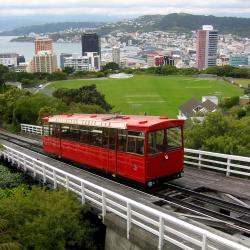 We spent our first day simply wandering around and catching some of the better museums. I can recommend to anyone that the first thing you should do in Wellington, so long as it is daytime, is to take the cable car to the top of hill that overlooks the city and then wander through the botanic gardens as you walk downhill back to the city. The part about downhill is very important. Downtown Wellington is shaped like a roughly-shaped bowl, open on the side that faces the harbor. As long as you stay near the water, you will not have to climb too many hills. However, leave the main downtown area and you will really give your legs (and lungs and heart) a work-out. After a couple of days, Kath and I have learned to ask questions of ourselves when planning a particular trek, such as: “How far up will this take us?” or “Is there a similar store that is not over that steep ridge?”
We spent our first day simply wandering around and catching some of the better museums. I can recommend to anyone that the first thing you should do in Wellington, so long as it is daytime, is to take the cable car to the top of hill that overlooks the city and then wander through the botanic gardens as you walk downhill back to the city. The part about downhill is very important. Downtown Wellington is shaped like a roughly-shaped bowl, open on the side that faces the harbor. As long as you stay near the water, you will not have to climb too many hills. However, leave the main downtown area and you will really give your legs (and lungs and heart) a work-out. After a couple of days, Kath and I have learned to ask questions of ourselves when planning a particular trek, such as: “How far up will this take us?” or “Is there a similar store that is not over that steep ridge?”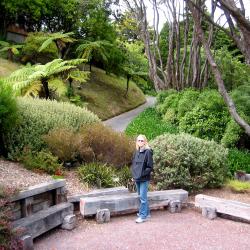 The museum that really got me excited about coming to Wellington was Te Papa, the new national museum opened only a few years ago. And, I can say that the museum really doesn’t disappoint, expecially since I mostly wanted to see exhibits concerning the experiences of the Maori people (the native inhabitants of New Zealand). I read several books regarding the inital impact of European culture on Maoris, and since most cultural sites revolving around Maori culture are located in the North Island, in places we weren’t going, I was keen to see what I could, especially if I could glimpse it in the mind’s eye of the “average” New Zealand citizen (or even want they wanted to project to the world). Te Papa does a great job of not only bringing Maori history and culture alive but also showcasing current and relevant Maori struggles in the perspective of the various participants, Maori and non-Maori alike. Te Papa is not scared to address issues that are not really settled yet and are still heavily contended. I learned a lot from the museum that I would have never picked up from books, and I guess that might as well be the definition of an important museum.
The museum that really got me excited about coming to Wellington was Te Papa, the new national museum opened only a few years ago. And, I can say that the museum really doesn’t disappoint, expecially since I mostly wanted to see exhibits concerning the experiences of the Maori people (the native inhabitants of New Zealand). I read several books regarding the inital impact of European culture on Maoris, and since most cultural sites revolving around Maori culture are located in the North Island, in places we weren’t going, I was keen to see what I could, especially if I could glimpse it in the mind’s eye of the “average” New Zealand citizen (or even want they wanted to project to the world). Te Papa does a great job of not only bringing Maori history and culture alive but also showcasing current and relevant Maori struggles in the perspective of the various participants, Maori and non-Maori alike. Te Papa is not scared to address issues that are not really settled yet and are still heavily contended. I learned a lot from the museum that I would have never picked up from books, and I guess that might as well be the definition of an important museum.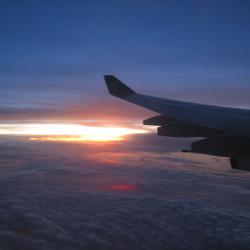 We made it to Wellington without incident, connecting through Tahiti and Auckland, as planned. Up to now, we had always flown across the Pacific in a complete leap, starting from Los Angeles or San Francisco and landing in Sydney or Auckland. In order to get the cheap seats to make this trip possible, we had to fly Air Tahiti Nui, the national airline of Tahiti, which stops for a few hours in Papeete, the capital of Tahiti, on the way to Auckland.
We made it to Wellington without incident, connecting through Tahiti and Auckland, as planned. Up to now, we had always flown across the Pacific in a complete leap, starting from Los Angeles or San Francisco and landing in Sydney or Auckland. In order to get the cheap seats to make this trip possible, we had to fly Air Tahiti Nui, the national airline of Tahiti, which stops for a few hours in Papeete, the capital of Tahiti, on the way to Auckland.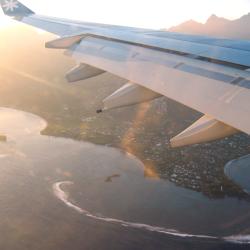
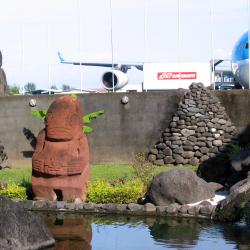
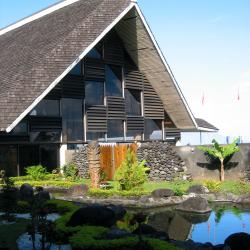
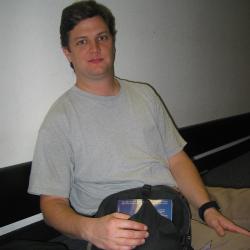 We arrived in Los Angeles from Little Rock via Houston with little incident. The Air Tahiti Nui flight boards in less than 1 1/2 hours, and the prospect of setting on plane for 8 hours, waiting, 3 hours, and then flying 6 hours more, only to sit in Auckland for 3 hours before flying on to Wellington, is, well, a little daunting. Though I’ve made flights of this duration quite a few times, I’m still a little amazed that it is possible to travel so far, so fast. I guess I should just find my seat, grab a drink, and reflect on how strange it is to be a 33,000 feet … while I’m at 33,000 feet.
We arrived in Los Angeles from Little Rock via Houston with little incident. The Air Tahiti Nui flight boards in less than 1 1/2 hours, and the prospect of setting on plane for 8 hours, waiting, 3 hours, and then flying 6 hours more, only to sit in Auckland for 3 hours before flying on to Wellington, is, well, a little daunting. Though I’ve made flights of this duration quite a few times, I’m still a little amazed that it is possible to travel so far, so fast. I guess I should just find my seat, grab a drink, and reflect on how strange it is to be a 33,000 feet … while I’m at 33,000 feet.